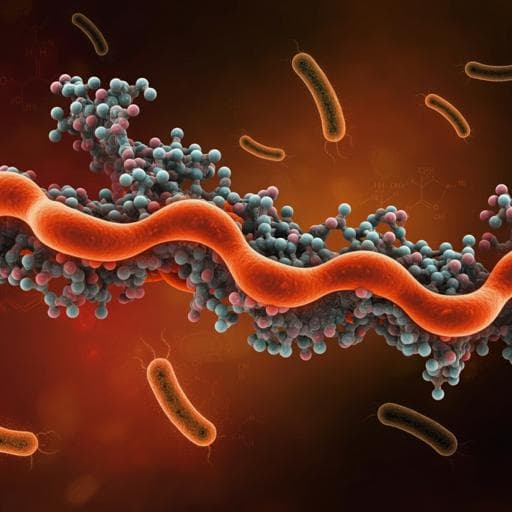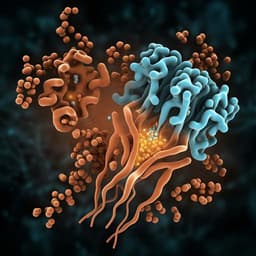
Food Science and Technology
Effects of sodium nitrite reduction, removal or replacement on cured and cooked meat for microbiological growth, food safety, colon ecosystem, and colorectal carcinogenesis in Fischer 344 rats
F. Guéraud, C. Buisson, et al.
This study unveils the intriguing effects of sodium nitrite reduction on cured and cooked meat, revealing decreased preneoplastic lesions while combating Listeria monocytogenes effectively. The research presents a multidisciplinary perspective on food safety and technology, conducted by a team of experts including Françoise Guéraud, Charline Buisson, and Nathalie Naud.
~3 min • Beginner • English
Introduction
Processed meat consumption is classified as carcinogenic to humans by IARC, with colorectal cancer (CRC) risk being a key concern. Nitrite and nitrate salts used as curing agents may contribute to CRC risk via endogenous formation of N-nitroso compounds (NOCs) and nitrosylated heme. While nitrite/nitrate additives provide antimicrobial, antioxidative, and organoleptic functions in meat, their role in carcinogenesis remains debated. Prior rodent studies showed that nitrite-containing processed meats promote colon preneoplastic lesions, whereas nitrite-free products reduced this promotion but increased lipid peroxidation and absorption of toxic alkenals. Epidemiological analyses distinguishing additive-derived from natural sources of nitrite/nitrate suggest additive forms are associated with increased cancer risks. This study aims to assess, in a multidisciplinary framework, how reducing, removing, or replacing sodium nitrite in a cooked ham model impacts: (i) endogenous nitrosation/nitrosylation and lipid peroxidation, (ii) the colonic ecosystem (microbiota and mucosal responses), (iii) preneoplastic promotion of CRC in azoxymethane-initiated Fischer 344 rats, and (iv) growth of Listeria monocytogenes during product shelf-life.
Literature Review
- IARC classified processed meat as carcinogenic (Group 1), linking intake to CRC risk; ingestion of nitrate/nitrite under conditions favoring endogenous nitrosation is probably carcinogenic (Group 2A).
- Experimental studies showed nitrite-treated meats promote colon preneoplastic lesions; nitrite-free meats reduced such promotion but increased lipid peroxidation and alkenal absorption.
- Epidemiology: meta-analyses suggest dietary nitrate associates with colorectal/ovarian cancer risk, but sources were not always distinguished. The NutriNet-Santé cohort distinguished additives vs natural sources, finding positive associations with nitrite/nitrate additives (not natural sources) for several cancers.
- Mechanistic insights implicate NOCs (e.g., NDMA) and nitrosylated heme derived from reactions between nitrite and heme iron; nitrosation and nitrosylation occur in product and during digestion.
- Nitrite/nitrate are used to inhibit pathogens (e.g., C. botulinum, L. monocytogenes), extend shelf-life, and maintain color/flavor; ≥30 mg/kg nitrite can prevent C. botulinum Group II type B outgrowth in ham models.
Methodology
Study design integrated product technology, microbiological challenge tests, toxicology in rats, fecal/urinary biomarker analyses, and microbiota profiling.
Cooked ham model production (carcinogenesis and biomarker studies):
- Six cooked ham model recipes produced in a ham factory with homogeneous curing: sodium nitrite at 120 mg/kg (Ni-120, reference), 90 mg/kg (Ni-90), or 0 mg/kg (Ni-0), and three nitrite-free alternatives: Vegetable Stock (VS; fermented vegetable broth with nitrate and starter), Polyphenol-Rich Extract (PRE; aroma rich in polyphenols and ascorbic acid), and Lallemand yeast extract solution with Staphylococcus xylosus starter (YE). Ingredient/additive details in Table 3; NaCl 18–20 g/kg; sodium ascorbate 0.3 g/kg present in Ni-120, Ni-90, Ni-0 and VS; not in PRE or YE.
- Processing: 80 kg ground pork tumbled 18 h, vacuum packed, steam cooked to 68 °C core (990 min; includes 50 °C/60 min for starter development), cooled to 4 °C, sliced (15 mm), packaged under 50% CO2/50% N2. Samples stored for biochemical analyses and for rat diets (with an intentional 3.5-day 4 °C pre-oxidation step before diet preparation to mimic poor storage).
- Biochemical characterization of products: total heme iron (acid hematin), nitrosylheme (% and µM, absorbance at 540 nm), TBARS (µg MDA/g), non-heme iron (Fe2+/Fe3+, ferrozine method), residual nitrite/nitrate (Griess assay), non-volatile N-nitrosamines, nitrosothiols; volatile nitrosamines (NDMA, NMEA, NDEA, NDIBA, NDBA) quantified by LC-(APCI)-MS/MS by Eurofins. ICP-AES for Fe and Zn. Interference checks for polyphenol effects on assays (e.g., EGCG spiking; additional controls for PRE formulations).
Listeria monocytogenes growth potential (challenge tests):
- Pilot-scale production of sliced cooked ham for 6 recipes mirroring above. Physical-chemical properties (pH, aw), gas composition, color (hue angle H*), TBARS, and nitrite/nitrate/Na measured per standards.
- Inoculation with a cocktail of three L. monocytogenes strains (Lm176 CC2, Lm212 CC101, Lm004 CC1) to ~2.0 ± 0.12 log10 CFU/g; packaging under 50% CO2/50% N2; storage 14 days at 4 °C then 35 days at 8 °C (supply chain simulation). Enumeration at multiple timepoints (D0, D7, D14, D17, D22, D28, D35, D49). Growth potential β = log10r − log10i; β > 0.5 log10 CFU/g indicates permissive growth (ISO 20976-1:2019). Analyses in triplicate batches; statistical analysis by ANOVA with pairwise Emmeans and Bonferroni correction.
Rat carcinogenesis study:
- Male Fischer 344 rats (12/group), azoxymethane i.p. 20 mg/kg to initiate CRC; 7 days later, randomized to 6 diet groups corresponding to the 6 ham models. Diets based on low-Ca, no-fat AIN-76 + 5% safflower oil, 45% (dry wt) ham, 8% gelatin; fed ad libitum for 98–99 days.
- Endpoints: Mucin-Depleted Foci (MDF) scoring in formalin-fixed colons stained by HID-Alcian Blue; number of MDF per colon, mucin-depleted crypts (MDC) per colon, and crypt multiplicity categories (>2 or >4 crypts/MDF). Blinded scoring.
- Biomarkers: Fecal waters prepared with BHT; fecal TBARS (MDA equivalents), fecal heme, urinary DHN-MA (major HNE metabolite) and 8-isoPGF2α by ELISA; fecal NOCs profiling (ATNC, RSNO, FeNO, RNNO) by chemiluminescence NO analyzer (CLD88) after differential pretreatments (sulfanilamide, HgCl2, K3Fe(CN)6) with 60 °C tri-iodide purge; controls to assess PRE interference (spiked fecal waters with EGCG/ferulic acid/ascorbic acid cocktail, no interference observed). Fecal water cytotoxicity (WST-1) and genotoxicity (γH2AX in-cell Western) tested on immortalized colon epithelial cells.
- Microbiota: 16S rRNA V3–V4 sequencing (Illumina MiSeq); processing with FROGS pipeline, chimera removal, prevalence/abundance filters yielding 318 clusters; taxonomic assignment with SILVA 138.1; alpha-diversity (Chao-1, Shannon), beta-diversity (Unifrac; MANOVA/Adonis 9,999 permutations), differential abundance at order/genus levels via DESeq2; visualization with mixMC normalization.
- Statistics: Outlier removal (ROUT), normality checks; ANOVA with Dunnett’s (vs Ni-120) or Tukey’s (alternatives) post-tests; data transformations for heteroscedasticity (log for DHN-MA, NOCs); Kruskal–Wallis/Dunn for non-normal data (some RT-qPCR and taxa); Welch’s ANOVA where unequal variances persisted; significance at p ≤ 0.05.
Key Findings
- Product chemistry (nitrite levels):
- Ni-120 vs Ni-90 vs Ni-0: Nitrosylated iron 110 ± 11 vs 83 ± 6 vs 10 ± 1 µM (% nitrosylation 58%, 57%, 9%); TBARS 0.041 ± 0.006 vs 0.042 ± 0.004 vs 0.303 ± 0.002 µg MDA/g (Ni-0 markedly higher, p ≤ 0.05); residual nitrate 24.95 ± 1.07 vs 14.59 ± 0.97 vs 4.51 ± 0.01 mg/kg; residual nitrite 9.36 ± 0.23 vs 6.76 ± 0.11 vs 0 mg/kg; nitrosothiols 2.05 ± 0.25 vs 1.38 ± 0.21 vs 0 mg/kg (all significant trends, p ≤ 0.05). Total non-volatile N-nitrosamines did not differ significantly across nitrite levels.
- Listeria monocytogenes growth (nitrite levels):
- All recipes ultimately supported growth (>0.5 log10 CFU/g) by D14. However, Ni-90 and Ni-120 significantly reduced growth compared to Ni-0 during the first 3 weeks (D7–D22; p ≤ 0.01), with no significant difference between Ni-90 and Ni-120. By D28, differences among nitrite levels were no longer significant.
- Endogenous NOCs and peroxidation (nitrite levels):
- Fecal ATNC, FeNO, and RNNO decreased dose-dependently with nitrite reduction; near-absence of fecal ATNC, FeNO, RNNO, and RSNO in Ni-0. Conversely, fecal TBARS and urinary DHN-MA increased dose-dependently as nitrite decreased, indicating elevated luminal lipid peroxidation and alkenal absorption with nitrite removal. Fecal heme levels did not explain peroxidation differences. Fecal water cytotoxicity and genotoxicity showed no significant differences.
- Microbiota (nitrite levels):
- No significant changes in alpha or beta diversity between Ni-120, Ni-90, Ni-0. Differential abundance revealed decreased Peptococcales and Peptostreptococcales-Tissierellales in Ni-0; genus-level trends included decreased Candidatus Soleaferrea, Romboutsia, Ruminococcus torques group, and increased Eisenbergiella and unknown Peptococcaceae/Lachnospiraceae with reduced nitrite.
- Preneoplastic lesions (MDF):
- Ni-90 reduced MDF number per colon versus Ni-120; Ni-0 showed a similar downward effect but not greater than Ni-90 (MDF p value near significance, p = 0.069). Total mucin-depleted crypts were significantly reduced by both Ni-90 and Ni-0; effects persisted when considering larger lesions (>2 or >4 crypts/MDF), with slightly less significance for larger lesions.
- Alternatives to nitrite (VS, PRE, YE):
- Product chemistry (Table 2): VS increased % nitrosylation (70%) and residual nitrite (13.56 mg/kg) vs Ni-120, with similar TBARS and residual nitrate; nitrosothiols decreased. PRE showed higher total non-volatile N-nitrosamines (7.09 ± 2.24 mg/kg) with very low residual nitrite/nitrate and unchanged TBARS. YE markedly lowered nitrosylated heme (20 ± 2 µM; 14%) and residual nitrite/nitrate, but increased TBARS (0.158 ± 0.021 µg MDA/g).
- Endogenous biomarkers: VS increased fecal ATNC and FeNO (p ≤ 0.05) without changing RNNO/RSNO, TBARS, DHN-MA, or fecal heme. PRE increased fecal ATNC, FeNO, RSNO and decreased RNNO (p ≤ 0.05), with unchanged fecal TBARS/heme but decreased urinary DHN-MA. YE decreased fecal ATNC, FeNO, RNNO, RSNO (p < 0.05) but increased fecal TBARS and urinary DHN-MA, without altering fecal heme.
- Microbiota: Alternatives differentially altered orders (Bifidobacteriales increased with YE; Desulfovibrionales decreased mainly with YE; Peptococcales increased with VS/PRE; Peptostreptococcales-Tissierellales decreased with PRE/YE). Beta diversity differed among diet groups (MANOVA p ≤ 0.001), with YE diverging most from Ni-120. Several genus-level shifts mirrored those seen with nitrite reduction/removal.
- Listeria growth: At D14–D22, PRE and YE exhibited higher growth potentials than VS or Ni-120 (p ≤ 0.0001). VS provided inhibition similar to 120 mg/kg nitrite for the first 3 weeks, consistent with nitrate-to-nitrite conversion by starter cultures.
- Preneoplastic lesions: None of the alternatives significantly changed MDF numbers vs Ni-120, though VS and PRE showed non-significant downward trends (ANOVA for MDC nearly significant: p = 0.064 and p = 0.071 for all lesions and ≥4-crypt lesions, respectively).
- Volatile nitrosamines: Five target volatile nitrosamines were below quantification limits in Ni-120 and all alternatives.
Discussion
Reducing or removing sodium nitrite profoundly affects product chemistry, microbial safety, and biological responses. Nitrite removal virtually eliminated fecal nitrosation/nitrosylation biomarkers but substantially increased luminal lipid peroxidation and systemic exposure to alkenals (urinary DHN-MA), which may offset additional anticancer protection compared with reduction to 90 mg/kg. In contrast, nitrite reduction to 90 mg/kg maintained effective control of lipid peroxidation (similar TBARS to Ni-120), decreased fecal NOCs, and reduced preneoplastic lesions without compromising early storage control of L. monocytogenes, performing comparably to 120 mg/kg nitrite during the first three weeks. Microbiota structure was largely preserved across nitrite levels, with only modest taxonomic shifts associated with nitrite removal.
Among alternatives, VS behaved similarly to nitrite (owing to nitrate conversion to nitrite), providing Listeria control and comparable product chemistry, but increased fecal ATNC and FeNO. PRE showed the clearest downward trend in preneoplastic endpoints without increasing lipid peroxidation and even reduced DHN-MA, yet increased fecal nitrosylation/nitrosation signatures and contained low non-volatile nitrosamines; assay interference was carefully evaluated and largely excluded, though colorimetric nitrosylheme assessment could be confounded by polyphenols. YE minimized fecal NOCs but substantially increased product and luminal lipid peroxidation and did not reduce preneoplastic lesions, highlighting the importance of controlling oxidation when removing nitrosating agents.
Overall, short-term risk management favors lowering nitrite to 90 mg/kg rather than complete removal for products with appreciable shelf-life, balancing cancer-related biomarkers and pathogen control. For nitrite-free formulations, co-application of antioxidants appears necessary to limit lipid peroxidation, reduce alkenal absorption, and potentially enhance protection against carcinogenesis. The data also emphasize that any alternative curing strategy should be evaluated not only for microbiological safety and product quality but also for impacts on endogenous nitrosation/nitrosylation and colon carcinogenesis promotion.
Conclusion
Reducing sodium nitrite from 120 to 90 mg/kg in a cooked ham model decreased fecal NOC biomarkers and preneoplastic colon lesions while maintaining early shelf-life inhibition of Listeria monocytogenes and controlling lipid peroxidation, offering a pragmatic short-term strategy to limit exposure to nitrite additives and nitrosated compounds. Complete nitrite removal further suppressed NOCs but caused marked increases in luminal and systemic lipid peroxidation without conferring additional protection beyond reduction, underscoring the need to control oxidation (e.g., with antioxidants) in low- or no-nitrite products. Among nitrite alternatives tested, vegetable stock (nitrate-based) performed closest to standard nitrite regarding microbiological control and product chemistry, polyphenol-rich extract showed a favorable trend on preneoplastic endpoints but increased nitrosylation/nitrosation markers, and the yeast extract solution failed to control lipid peroxidation or reduce preneoplastic lesions. Future work should evaluate antioxidant enrichment of low-/no-nitrite meats to further mitigate lipid peroxidation while reassessing endogenous NOC formation, and extend validation across diverse products, storage conditions, and human-relevant outcomes.
Limitations
- Animal model (azoxymethane-initiated F344 rats) at the preneoplastic stage may not fully translate to human CRC risk; tumor outcomes were not assessed in this experiment.
- Specific cooked ham model and defined storage conditions may limit generalizability to other processed meats and real-world supply chains.
- Only three alternative curing strategies were tested at supplier-recommended doses; broader dose–response and additional alternatives were not evaluated.
- Listeria challenge used three strains and specific packaging/gas conditions; results may vary with other strains or processing/packaging parameters.
- Potential analytical interferences for nitrosylheme measurement in PRE formulations (polyphenols/Zn protoporphyrin) were considered; although controls were performed, some uncertainty remains for colorimetric nitrosylheme in PRE.
- Presence of sodium ascorbate differed between some formulations (e.g., absent in PRE and YE), potentially confounding comparisons by affecting oxidation and antimicrobial effects.
- Volatile nitrosamines were below quantification limits for targets measured; other nitrosating species or unmeasured volatile nitrosamines cannot be entirely excluded.
Related Publications
Explore these studies to deepen your understanding of the subject.







